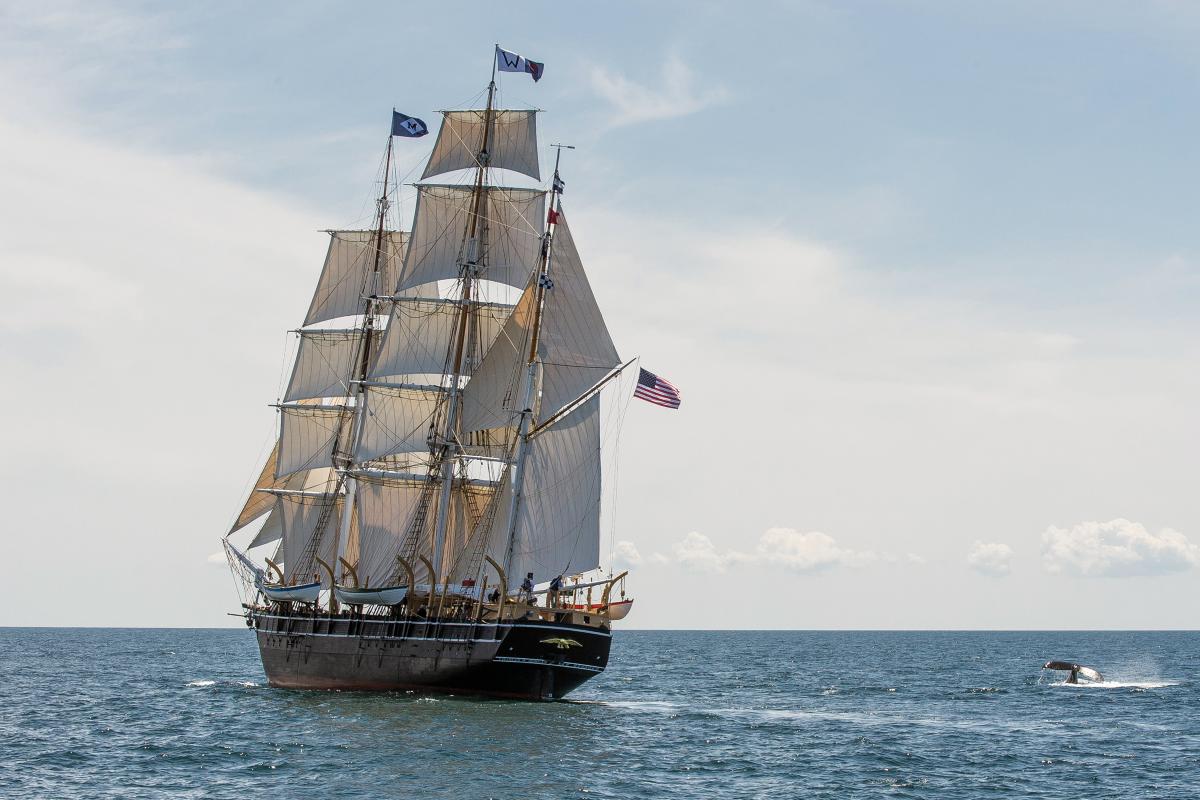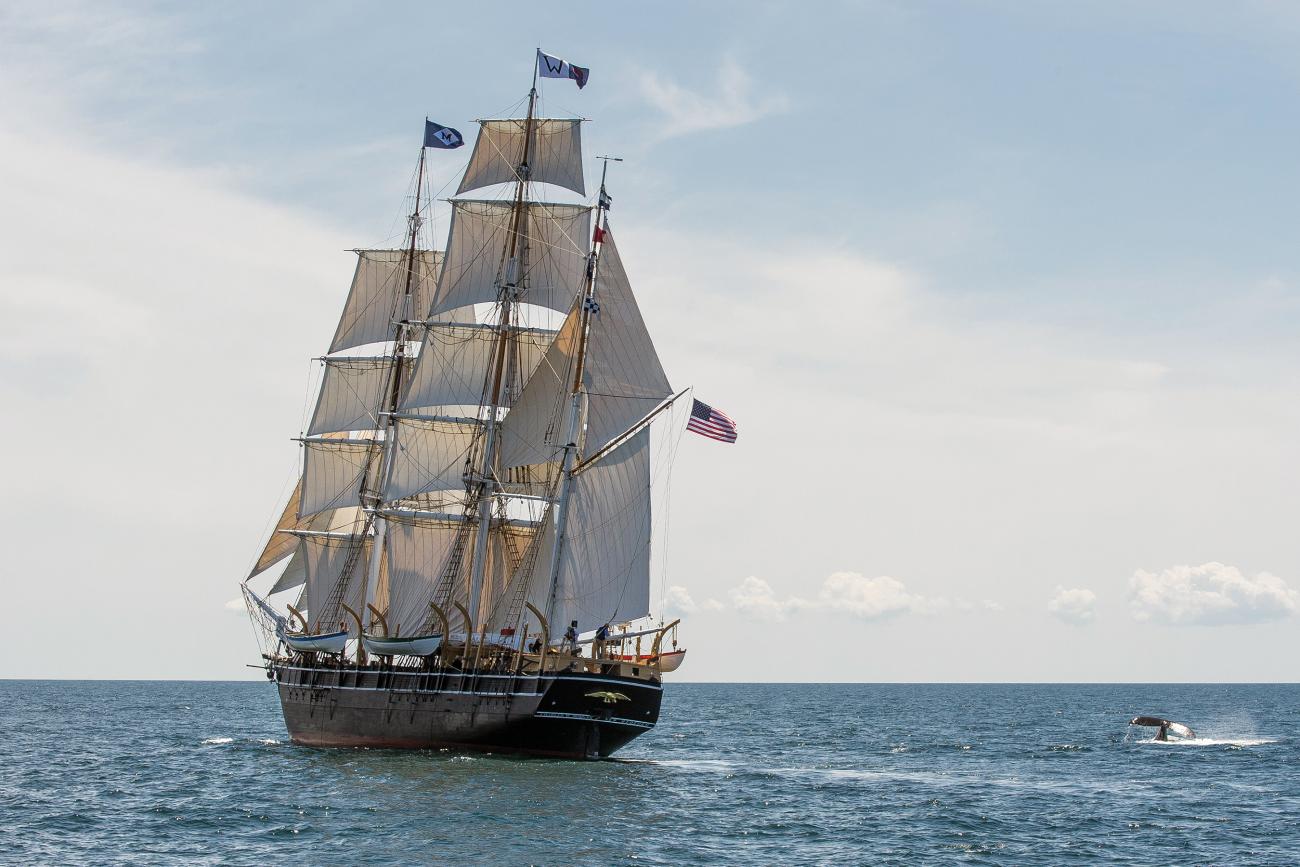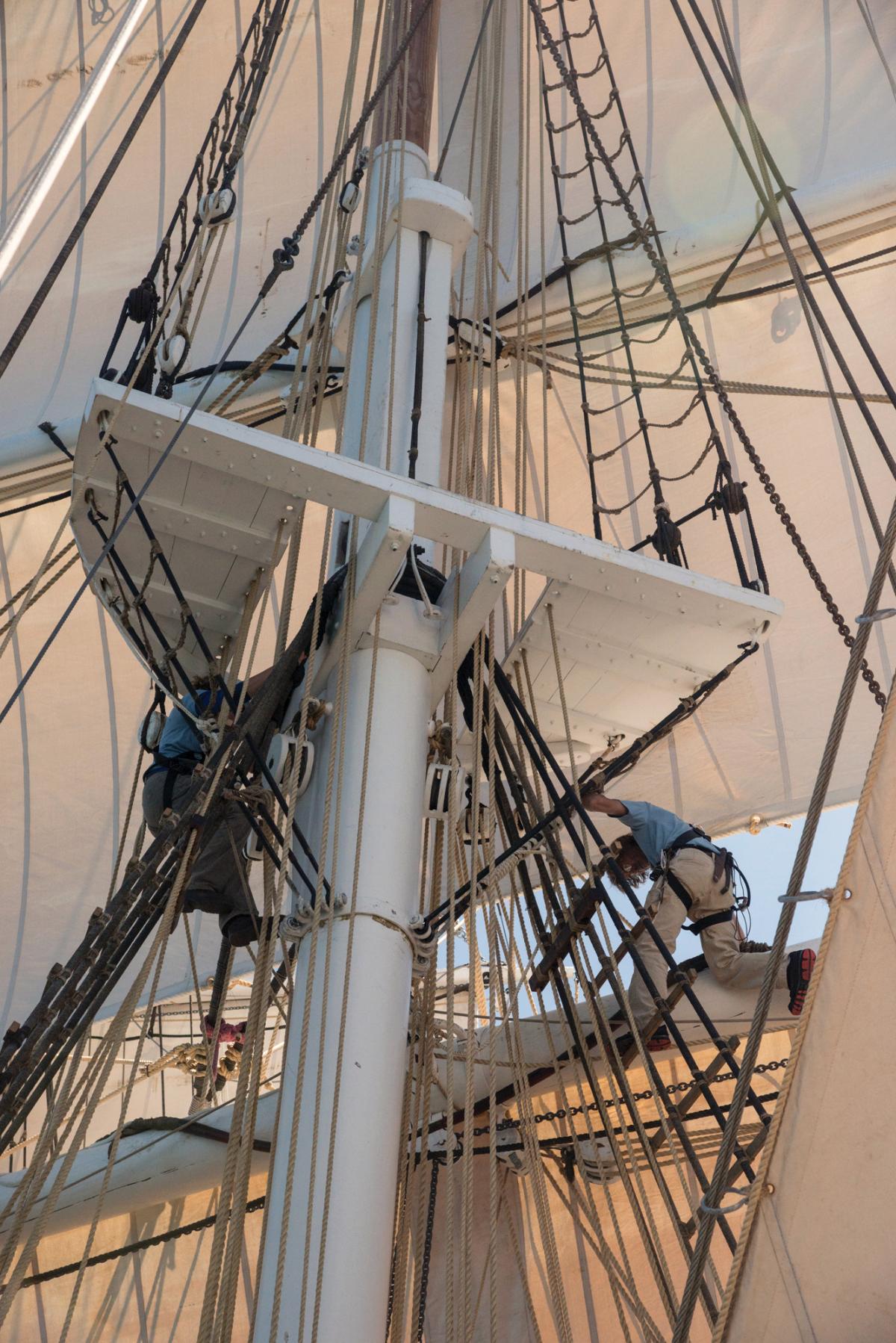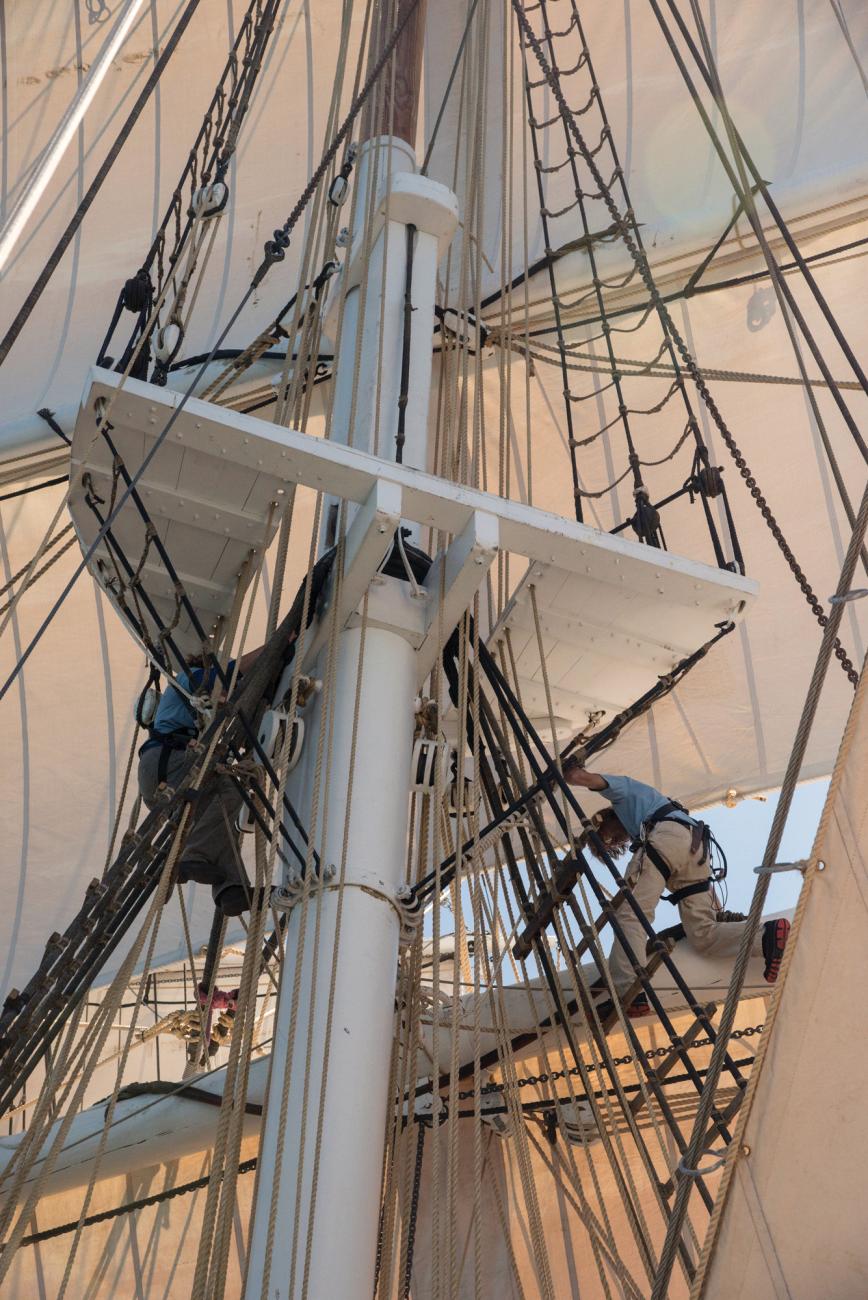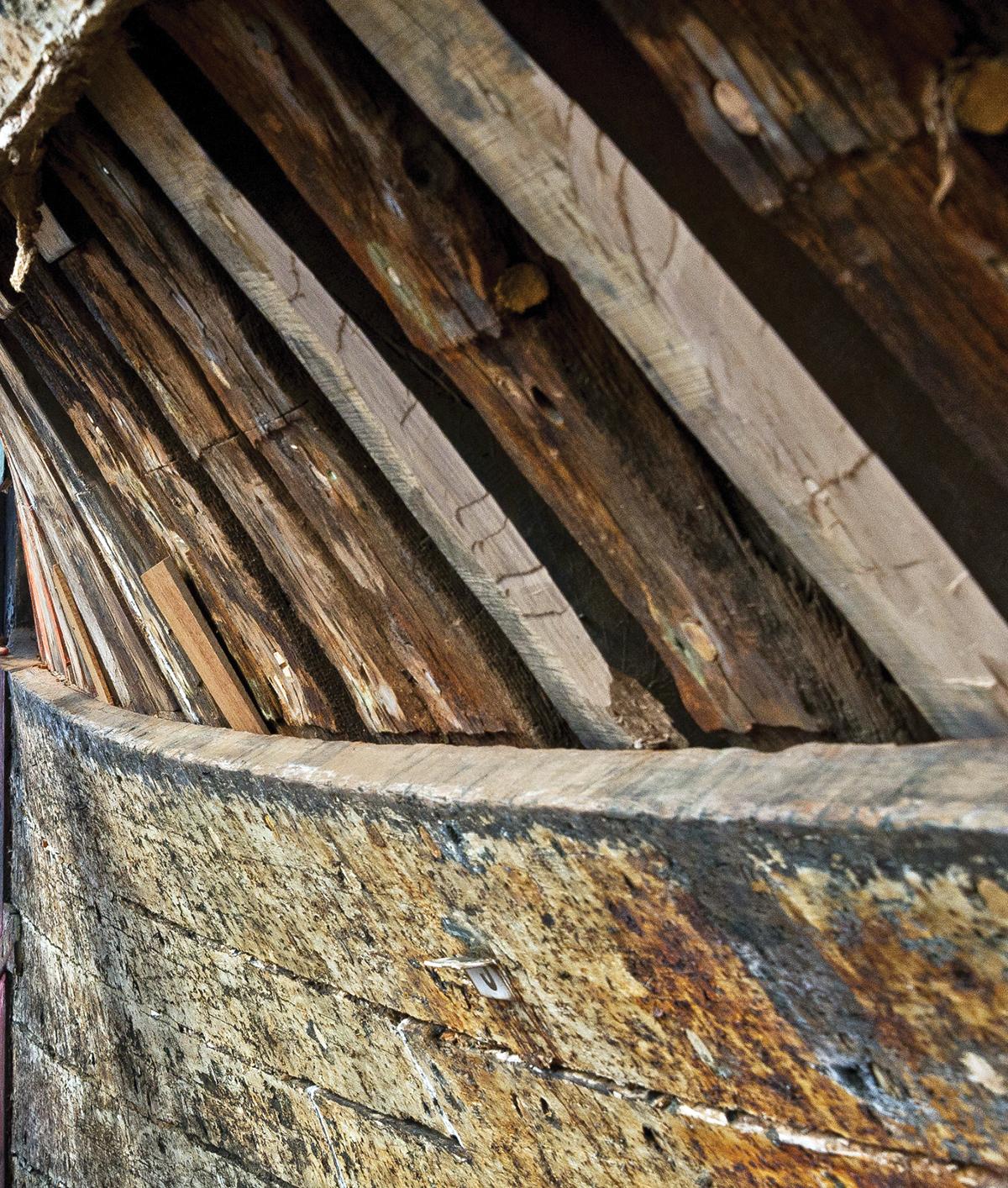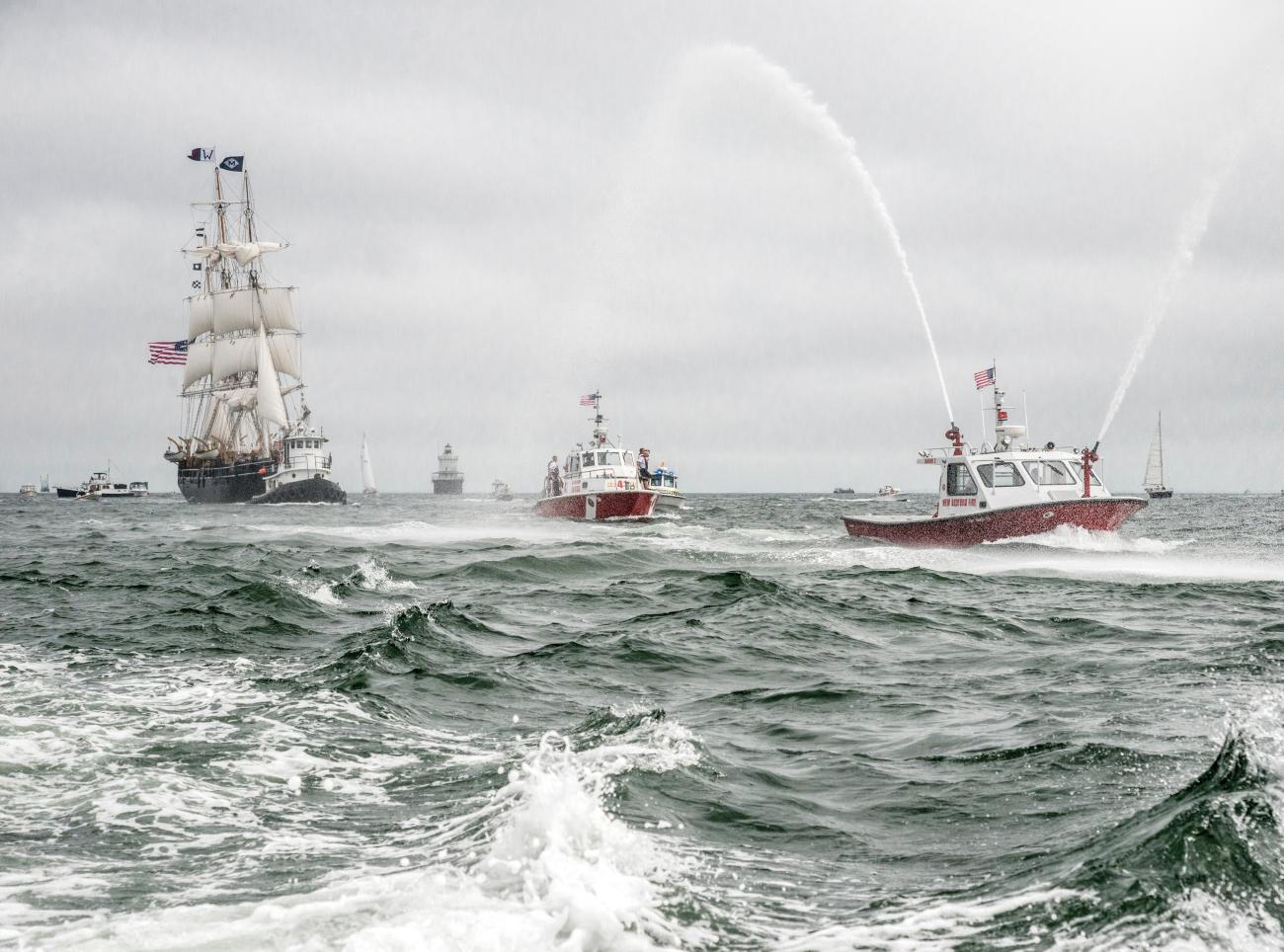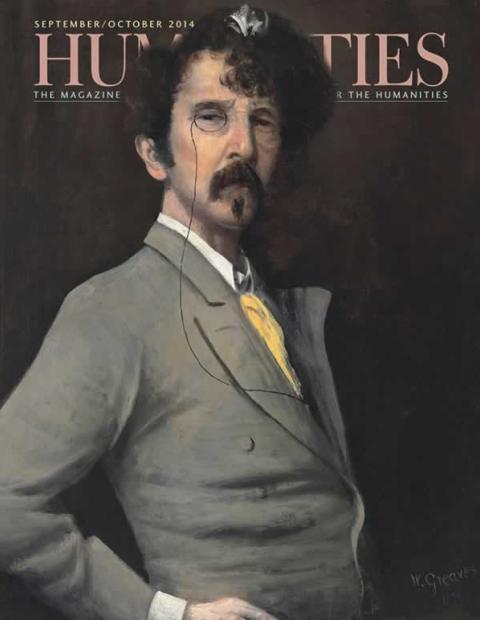In 1844, Nelson Cole Haley, a twelve-year-old boy from New Bedford, Massachusetts, ran off to sea. His father had died, and despite his mother’s objections, the boy was determined to become a whaleman.
As crazy as it now sounds, Haley’s story was not unusual for the era. This was at the height of the whaling industry, and the U.S. fleet was the world’s largest, sending more than 2,700 tall ships to crisscross the oceans. These whaleships were at sea for three to five years at a time, and they returned laden with baleen—the plastic of its day—and the oil that fueled household lamps and then the Industrial Revolution.
The epicenter of that business, New Bedford, was then the richest community in America—“the City that Lit the World.” So, for a boy like Haley, a whaleman’s life must have seemed irresistible. He got a deckhand’s job and practiced his harpooning skills on sharks and dolphins, and in 1849 he landed a prime position as a harpooner on the Charles W. Morgan. Years later, Haley wrote a memoir of his four-year voyage on the Morgan, which was published as Whale Hunt and reissued by the Mystic Seaport Museum in 2013. In it, he describes approaching a massive humpback from the bow of the twenty-five-foot whaleboat just as the sun sets:
It was a glorious sight, sitting on the gunwale of the boat, facing towards the whale that lay so still with his hump sticking some two or three feet above his back, which was hardly buried except when he slowly dropped his immense head and sent a swash of the sea rolling across it, after blowing from his spout hole his breath in such a lazy and quiet manner that the sound of it could not be heard more than a hundred yards away, calm as it was.
And then, moments later, the attack: “I raised the iron, and with all the force I was capable of, I sent it to the socket into the vast mass of blubber and meat that was now only a foot or two clear of the boat. The next instant I had planted the second iron within a foot or two of the first, just as the sun reached her lower limb in the western horizon.”
As dusk settled, the second mate slayed the whale with his lance, and the crew rowed the massive carcass back to the ship to be butchered and rendered in the morning. Haley’s trip aboard the Charles W. Morgan was all the adventure a boy could hope for, and the ship proved lucky, surviving a terrifying becalming and cannibal attacks. Its luck has not changed.
Over one hundred seventy years later, the Charles W. Morgan is the only surviving whaleship from those glory days (she’s also the oldest U.S. commercial ship afloat—only the U.S.S. Constitution is older). This summer, visitors to New Bedford and several other historic New England ports were given the once-in-a-lifetime chance to see the Morganunder sail. Restored and made seaworthy, the Morgan made a historic journey up the East Coast, stopping in ports that once made their fortunes off whale oil. Along the way, thousands of visitors, including many descendants of whalemen like Nelson Haley, were able to walk the ship’s decks, row whaleboats alongside her, listen to sea shanties, and soak up traveling and local exhibitions of whaling art and lore at dockside.
The Morgan’s restoration and return to the sea after almost a century in hibernation was masterminded by Mystic Seaport. Last sailed in 1921, the Morgan had been berthed in South Dartmouth, Massachusetts, until damage from the Hurricane of 1938 made it clear that she needed a safer harbor. So, in 1941, she was tugged to Mystic Seaport, where more than twenty million visitors have walked her decks. In 2008, the museum undertook a massive restoration project, which evolved into an even more ambitious plan to make the Morgan seaworthy and to sail her once more. In all, the project cost $7 million and involved scores of other cultural, educational, and scientific organizations, ranging from the National Endowment for the Humanities to the New Bedford Whaling Museum to the U.S. Coast Guard and the National Oceanic and Atmospheric Administration.
Everywhere the Morgan went, crowds of admirers gathered, waiting in long lines to get on board. But the most moving and symbolically significant leg of the journey may have been the several days in July that the old whaleship spent sailing among her erstwhile prey in the Stellwagen Bank National Marine Sanctuary, north of Provincetown, Massachusetts. There she serenely glided among humpbacks while the crew and visitors onboard marveled at the whales’ grandeur. “It was amazing,” says University of Connecticut oceanographer Michael Whitney, who was there to monitor coastal and ocean currents. “I knew where we were going, and I knew whales had been seen in the area, but I didn’t let myself expect that we’d actually see them. It was the first time I’d ever seen a humpback feeding.”
This summer’s journey was over a century and a half in the making. Originally commissioned by her namesake, the Quaker businessman and abolitionist Charles W. Morgan, the Morgan was built in the New Bedford shipyard of Jethro and Zachariah Hillman in 1841. The Morgan and her smaller, older cousin—the ill-fated Essex, which Herman Melville immortalized as the Pequod in Moby-Dick—were heavy, solid working ships, designed for durability and longevity more than speed or beauty.
They weren’t luxurious either. While the Morgan was docked at New Bedford’s State Pier the week of July 4, I spent some time onboard with Ryan Leighton, a young newspaper reporter from Maine, whom Mystic Seaport had chosen to travel as the “stowaway.” Unlike real-life stowaways, Leighton had a media-relations job: to tweet, blog, and make videos about his experience. As we headed below decks to check out the hold, a small boy in a Superman T-shirt called out, “Hey, Dad, I can touch the ceiling!” The six-foot-four-inch Leighton was bent nearly double in the cramped space. “No one cared much about the comfort of the crew on a whaleship,” he joked.
In the hold, Leighton pointed out bundles of wooden staves that the ship’s cooper would assemble into barrels as needed, keeping space free until it was needed for oil. Into the spaces between the thirty-gallon barrels, he explained, narrower casks would have been wedged so that the barrels wouldn’t shift and capsize the ship.
Those narrow casks, Leighton said, were used to store spermaceti, the precious liquid wax found in the sperm whale’s head (and responsible for its name, since it resembles semen in consistency). Since spermaceti doesn’t smoke when it burns, it was prized for candles and lamp oil in the eighteenth and nineteenth centuries. And later, in the late nineteenth and twentieth centuries, it came into even greater demand as an industrial lubricant; because spermaceti doesn’t freeze at low temperatures, NASA is purported to have used it on spacecraft, Leighton said.
As Leighton led me up on deck, we found several members of the crew sitting on the wooden windlass, the trunk-like winch that was used to crank dead whales up alongside the starboard side of the ship to be butchered. There, with sharks frenziedly feeding at their feet, the crew would carefully balance on the carcass, peeling away strips of blubber that were hoisted onboard and carved into what the whalers called “bibles,” book-like chunks that could be rendered like lard. Leighton explained that the bibles were tossed in two huge metal pots atop the tryworks, a massive brick furnace on the deck. Once “tried out,” or rendered, the liquid whale oil was funneled down below into barrels. The remaining cracklings, he said, were then burned for fuel in the tryworks.
The stench must have been overwhelming. The trying out “would go on all night,” Leighton said, “sometimes for two or three days—like Dante’s Inferno.”
Between 1841 and 1921 the Morgan made thirty-seven voyages, each three to five years long, under the leadership of twenty-one captains. When I asked the current captain, Kip Files, of Rockland, Maine, how it felt to sail such a historic treasure, he replied dryly, “I’m the twenty-second captain, and I don’t want to be the last. I don’t push her.”
In her eighty years at sea, the Morgan circled and re-circled the globe in pursuit of whales, zigzagging her way across the oceans from the Arctic to the Azores and from New Zealand to Hawai’i. As they traveled, her crew traded tobacco and fabric for provisions, and dropped off seasick and burned-out sailors and replaced them with fresh recruits as she went. Over the course of her sailing life, the Morgan carried sailors from fifty countries—men of every color.
Leighton described the culture on nineteenth-century whaleships as surprisingly meritocratic. Although most captains and officers came from established New England families, “there were African-American captains and Wampanoag captains,” Leighton said. “Whaling took a special type of man. There was a task to be done—to get as much oil as possible—and if you could do the job you would rise through the ranks.” Perhaps the most critical job in whaling was Nelson Haley’s—that of the harpooner—and in Moby-Dick, Melville gives that job to Tashtego, the fictional Gay Head Wampanoag.
Hailing from all over the world, whalers had their own common language, “sailor pidgin,” says Wyn Kelley, a Melville scholar at the Massachusetts Institute of Technology. She and University of Connecticut oceanographer Mike Whitney were among the seventy-nine artists, scholars, and descendants of whalers who were given the chance to sail on a leg of the Morgan’s trip through an NEH-funded program called the 38th Voyagers. Each voyager proposed a project to conduct on the trip, and spent a night and the following day aboard. Back on land, each of the voyagers will produce a creative project that Mystic Seaport staff plan to share with the public, whether through exhibitions, online, or in print publications.
For Melville scholars and Moby-Dick fans, sleeping and sailing on the Morgan, was a chance to see and touch and smell and feel things they’d only read about. That might seem thrilling enough. “But this was so much more than standing where Melville stood,” Kelley says. While sailing on the Morgan, she showed Melville’s poem “Clerk of the Weather” to the crew and other voyagers and queried them about its language. She says that she came to see that Melville was talking about ways to read the weather at sea, through the wind and birds: the gannet and the pintado.
Journalist and painter Ben Shattuck grew up sailing off the Massachusetts coast and loving Moby-Dick. He says he imagined that sailing on the Morgan would enable him to get inside the head of Ishmael, the novel’s narrator. Shattuck proposed writing a series of essays and blog posts from that experience. When the Morgan set off from Newport, Rhode Island, for Martha’s Vineyard, however, twenty-first-century reality made it hard to hear Ishmael’s voice. “Everybody on deck had their cell phones out,” Shattuck says. But then the Morgan rounded Naushon Island, and he glimpsed the undisturbed meadows and woods on its backside. “I could imagine that it hasn’t seen a whaleship since the 1920s.” There, he found Ishmael. And, Shattuck says, “I saw a gannet.”
Not all of the voyagers were pursuing Melville’s ghosts. Ansel Elkins, who grew up in Alabama and lives in Greensboro, North Carolina, was there to write poetry. On an earlier trip to Mystic Seaport, she’d been enraptured by an exhibit of a sailmaker’s loft. It inspired her to write a poem in the sailmaker’s voice, and she was eager to spend time on the Morgan. On shipboard she soaked up the smells of the pine-tar caulking, the fog-soaked hemp rigging, the wet wood of the decking beneath her bare feet. She says she loved the quiet down below, “near to the oldest part of the ship, in the keel—where the ship was born. I thought of all these hands that had given it birth.”
Elkins says she was struck by the multitude of skills and languages that the Morgan’s whaling crew brought together in the nineteenth century. “It’s amazing how cosmopolitan these ships were,” she says. And she found a similarity in her brief twenty-first-century sojourn among the crew and voyagers. “We all have these very specific skills,” she says. “I loved interacting, talking with all these other people on the ship about how they see things and what their interests are.”
In the end, Elkins describes the trip as “one of those rare experiences that you have no way to prepare for. I felt completely alive to the experience of it; awake to the sheer adventure of it.”
For stowaway Leighton, who spent the entire summer onboard, the trip may be even more significant. He’s been reading Whale Hunt and reveling in Nelson Haley’s tales of Nantucket sleigh-rides (being pulled by a fleeing whale) and the threat of cannibal attacks. When Leighton told his newspaper colleagues about landing this stowaway job, they laughed. “They said I was playing pirate,” Leighton said, grinning madly and holding the sides of his head like it might burst. “I’m in the middle of a life-changing experience,” he said. “I know it!”




